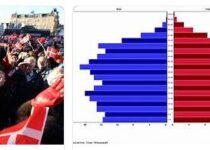Hamburg, Germany Attractions
After the city fire of 1842, which destroyed almost a third of the buildings in the city center, extensive urban changes began. The urban planning activities of F. Schumacher (1909–33) had a formative effect at the beginning of the 20th century. Despite the construction of numerous high-rise office buildings after the Second World War, the towers of the five main churches remained decisive for the silhouette of the city.
The main church Sankt Petri (probably founded as early as the 11th century, new building in the 14th century) was built as a four-aisled neo-Gothic brick hall church after the town fire in 1844-49, the tower 1873-77. The former main altar by Master Bertram (1379, today Kunsthalle) was one of the valuable furnishings. Only the 145 m high tower (1882) of the former main church Sankt Nikolai has been preserved, a replacement building was built in Harvestehude by Gerhard Langmaackin 1961–63built. The main church Sankt Katharinen (attested in the middle of the 13th century), originally a small three-aisled stepped hall, was replaced by a large pseudo-basilica from the middle of the 14th century until after 1450 (rich furnishings); the western tower facade (1732–37) has a double Welsh hood. The main church Sankt Jacobi (14th / 15th century; first mentioned in 1255) with the Trinity altar of the Böttcher (before 1518) also has a Schnitger organ (1689–93). The main church Sankt Michaelis is a stately baroque building, its west tower (“Michel”) is the landmark of Hamburg; next to it are the Krameramtswohnungen (1676/77).
The town hall was built in the historicist style between 1886 and 1897 with the participation of several architects. From the 19th century come, among others. the Kunsthalle (1863–68; with extensions 1914–19 and 1956 as well as an extension – Galerie der Gegenwart – by O. M. Ungers, 1992–97), the State Opera (originally built as a municipal theater in 1827; remodeling 1873–77 and 1925–26, 1953 –55 new construction of the auditorium destroyed in 1943), the stock exchange (1839–41; restored in 1950 and adapted to modern business transactions) and the old post office (1845–47; redesigned 1969–70). The following buildings from the early 20th century should be mentioned: the music hall (1904–08; the Brahms monument by M. Klinger in the foyer, 1909), the Landungsbrücken (1907–09) and the Elbe tunnel (1907–11) in monumental Art Nouveau style as well as under the buildings of Schumacher the Post Customs Office with its elongated brick facade (1913–15) and the Museum of Hamburg History (1914–23). One of the most impressive examples of architecture from the 1920s is the Kontorhausviertel with Chilehaus (1922/23, a major work of clinker expressionism; by F. Höger; world cultural heritage since 2015), Meßberghof (1923-25, by Hans and Oskar Gerson), Sprinkenhof (1927–32, by H. and O. Gerson and Höger) and Mohlenhof (1928).
Further examples of early modern office buildings are Hapag-Haus (1923) and Shell-Haus (1929–31, by E. G. Fahrenkamp). The area around the Inner Alster with the Jungfernstieg is very attractive in terms of urban planning. The Inner and Outer Alster are connected by the Lombard Bridge (1865–68, widened in 1900) and the Kennedy Bridge (1952). Among the numerous new business buildings of the post-war period, the following should be emphasized: the Springer high-rise (1956/1957, by Pruter & Streb), the Emporio-high-rise (formerly Unilever-Haus; 1959-64, based on a design by H. Hentrich and H. Petschnigg), the administration building of Deutsche Ring AG (1962–64, by Joachim Matthaei and H. Graaf), the administration building of Vattenfall Germany (1962–70, by A. Jacobsen). From the 1970s onwards, numerous shopping malls were built, partly through the renovation of old building complexes while preserving the exterior. Most of the passages are in the area between Rathausmarkt, Gänsemarkt and Colonnaden (including »Gänsemarkt-Passage«, »Hamburger Hof«, »Hanse Viertel«, »Galleria«). The area of the Fleetinsel between Alsterfleet and Herrengraben was rebuilt from 1988. Notable examples of architecture that emerged under the influence of postmodernism include: the publishing house of Gruner + Jahr AG & Co. (1987–90) by the Munich architects O. Steidle and Uwe Kiessler, buildings by the Hamburg architects Konstantin Kleffel and Uwe Köhnholdt (including brick building of the new music theater “Neue Flora” on Holstenwall, 1990) as well as the Galerie der Gegenwart von Ungers (1992–97), which marks the end of the “art mile” between the Alster and Elbe.
The university quarter (planning: Paul Seitz) with the Auditorium Maximum (1958/59) by Bernhard Hermkes and the America House (1957) by Seitz are located in the Rotherbaum district.
The Speicherstadt, built between 1884 and 1910, with its warehouses and office buildings in the historicism style, which was extensively renovated in the 1990s, is located on the canals (canals) of the former free port. In 2015 it was declared a UNESCO World Heritage Site together with the Kontorhausviertel and the Chilehaus. The new wholesale market hall was built in Hammerbrook in 1958-62. The Deichtorhallen (1911-13), originally a flower wholesale market, were opened in 1988/89 by J. P. Kleihues converted into exhibition halls (since 2005, among other things, the seat of the House of Photography). The most important urban development project in the Hanseatic city is currently HafenCity. In the immediate vicinity of the city center, a new waterfront district with around 5,500 apartments as well as areas for services, culture, trade and tourism is being built on 157 hectares of the former port area. In 2008 the International Maritime Museum was opened here; the new Elbphilharmonie (architects Herzog & de Meuron; construction started in 2007, opening January 2017) was also built in HafenCity.
In the Elbe suburbs there are still many representative classicist country mansions, for example in Blankenese the houses on the Elbchaussee in an architectural style coined by C. F. Hansen, among others. the Jenisch House in a park (1831–33, now a museum). Other villas were built by H. van de Velde, B. Paul, H. Muthesius, P. Behrens and Martin Elsässer (* 1884, † 1954). In addition to the residential complexes built from 1929 (e.g. on Jarrestraße), further residential developments were added after 1945, for example on Grindelberg (1948–56, ten high-rise buildings), in Langenhorn, Bahrenfeld, Wandsbek and others. Suburbs; 1970–76 the residential town of Steilshop was built; in Harburg built I. and F. Spengelin a residential area.
The new Christianeum (1970) by A. Jacobsen and the »factory« converted into a communication center by Gerkan, Marg & Partner are located in Altona. In Altengamme there is a rococo church (1748–52); Allermöhe, Neuenfelde, Neuengamme, Niendorf, Ochsenwerder and Ottensen have other rural churches.



